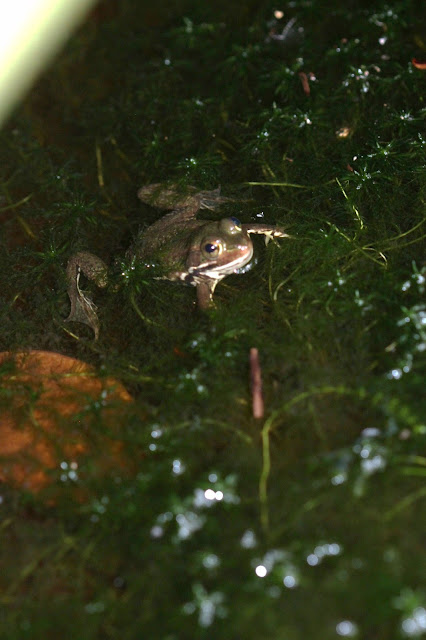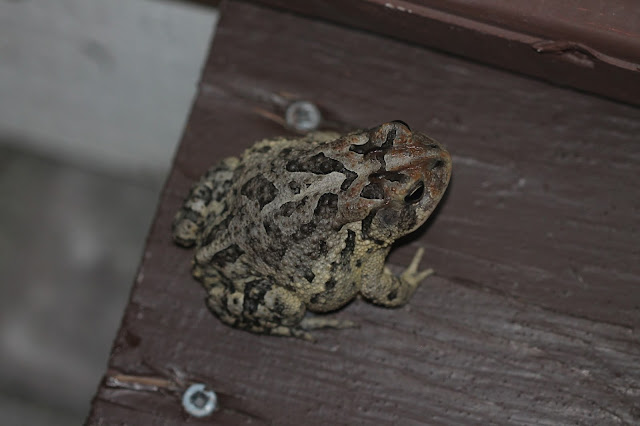So anyway, here is a wrap-up from a short trip Aimee and I took to South Carolina between June 24th and 28th. My father moved down there last year, and we were sort of "due" to visit. I was actually very excited about the prospect of field herping a state I had never been to before. I had a list of a bunch of places I wanted to visit, but like all trips in which the primary goal is NOT field herping, my reptile-seeking endeavors took a back seat to being with family and all that, which is fine. The good news is that this was South Carolina - one of the richest herpetofaunal regions of the United States. It turned out that I didn't need to even leave the backyard to find awesome animals - even though I did that, as well.
Out first real exposure to South Carolina ecosystems was a trip to an intact Carolina bay near Olanta. I went to see alligators, but we saw so much more than that. Our first herps were several bronze frogs (Lithobates clamitans "clamitans"). They were in a pathside ditch as we walked toward the larger, open-water bay.
Almost immediately after stepping to the boardwalk across the water, I spotted this American alligator (Alligator mississippiensis) basking on an old pier piling. I had been so amped about possibly seeing an alligator for the first time in nineteen years, and here was one off the bat!
We not only saw this one, but about six or seven others, all younger animals who were quite skittish. I really hoped to see Momma around, but that didn't happen. Here's another gator we saw, on another piling.
The vegetation quickly closed in as the habitat transitioned from open water cypress-tupelo swamp to shrub bog, one of very few good examples left in the entire state.
We observed a number of five-lined skinks (Plestiodon fasciatus) running every which way. This was actually the best photo I was able to get of one.
These looked like blueberries we eat, but the plant they grew on didn't remind me of any blueberry plants I have seen up North. I ate a few of these, and they didn't have much taste (they certainly didn't taste like blueberries I've eaten). I'm not dead, so I guess these aren't toxic.
As we made our way down the raised walkway, I scanned the ground in hopes of finding an Eastern cottonmouth. Imagine my surprise and intense satisfaction when I instead saw this:
A gorgeous young timber rattlesnake (Crotalus horridus), otherwise known in these parts as a canebrake. This animal calmly remained coiled as I shot about fifty pictures of it. What an astounding animal.
As I took the last few shots, Aimee shouted my name from up the walkway, where she had wandered. I heard her say something about a snake - I was off! About fifty feet up, she was there, pointing into a mass of tangled branches and vines, where an Eastern cottonmouth (Agkistrodon piscivorous "piscivorous") was foraging. It had been spooked by our arrival and took off, but not before I was able to get one crappy voucher shot.
The bugs are big and loud in South Carolina swamps. This hoverfly would not leave us alone. I was lucky it decided to stop and rest so we could split before it found us again.
One of the most surprising finds for me at the bay were the carpenter frogs (Lithobates virgatipes) I saw. And really, there was no reason to be surprised at all, since this was perfect habitat and well within their limited range on the Atlantic coastal plain. I just didn't even think about the species in planning the outing. So, when I heard a few characteristic carpenter frog calls (which sound like someone hammering nails, hence the name), I had to spot some for photos. I found that they were primarily hanging out under the walkway. When I saw one close enough to photograph, I had to break out my non-existent contortionist skills to get some shots without either dropping my camera into the mire or falling into the water myself and becoming gator fodder. Unfortunately, this photo was the best I was able to get, under tough lighting conditions (and while compromising the integrity of my spinal column). A new species for me, and that's just fine.
That evening, Aimee and I went to the store, and perched on the outside of the building was this amazing antlion (family Myrmeleontidae). I had never seen anything like this. Such a beautiful insect.
The next day, a trip to Charleston, and to the famous Angel Oak, a centuries-old, massive Southern live oak (Quercus virginiana). If you see this tree and are not in awe, there very likely is something wrong with you.
Late at night in the backyard was this Southern toad (Anaxyrus terrestris) hunting cockroaches. It was hot and the humidity was stifling. The mosquitoes were in full force, so I didn't spend any time getting "naturalistic" shots - in fact, this shot better represents this toad's habitat.
At a small wooded suburban park, Aimee and I walked along a small river, occasionally tripping over cypress knobs and constantly walking into spider webs not unlike this one.
I rolled a few logs and found two marbled salamanders (Ambystoma opacum). It was very warm outside, and these little gummy lizards were quite squirmy and hard to photograph.
A very hard reptile to photograph - the ground skink (Scincella lateralis). I chased this one around in the leaf litter (where it lives), but I couldn't take a picture unless I placed it on the tree (where it doesn't live, usually).
A beautiful golden silk orb weaver spider with prey.
We kept our eyes peeled for turtles along the small river in this park. Most were hard to identify due to the thick growth of algae on their shells, but I'm pretty sure I saw some sliders, cooters, and at least one musk turtle. Here's a cropped photo of a Florida cooter (Pseudemys floridana).
On our final day in South Carolina, I decided to poke around in the yard once more before calling it quits. In the back of the yard is a shed and kind of "control center" for the swimming pool. Behind the shed are a bunch of five gallon buckets, lids, and other junk. I had searched here a few times in the previous days and found nothing but cockroaches. But on my final pass, under the last bucket lid, I flipped this smooth earth snake (Virginia valeriae). I was pumped. I put it back where I found it much to the ire of my father, who believes all snakes ought to be killed (yeah, he's one of "those" people). I assured him that the snake would eat garden pests, and hoped for the best.
























No comments:
Post a Comment